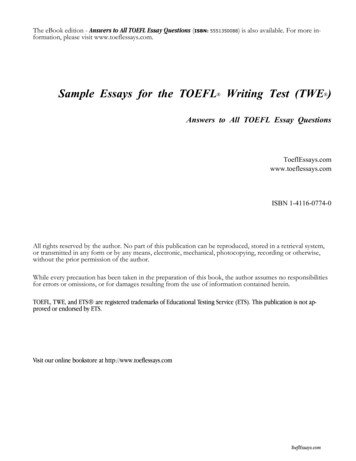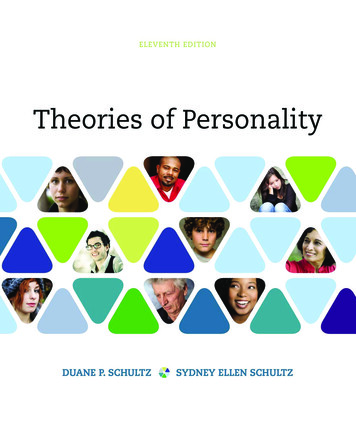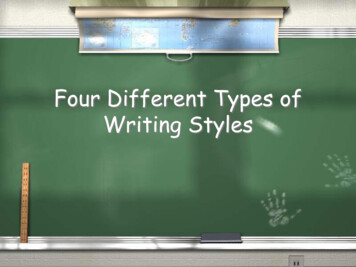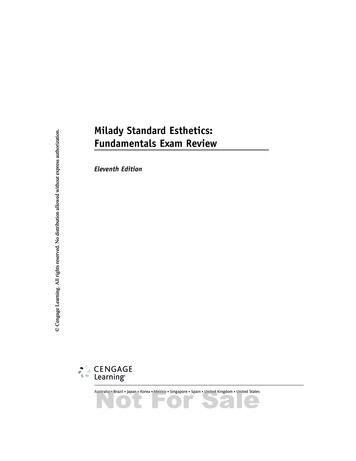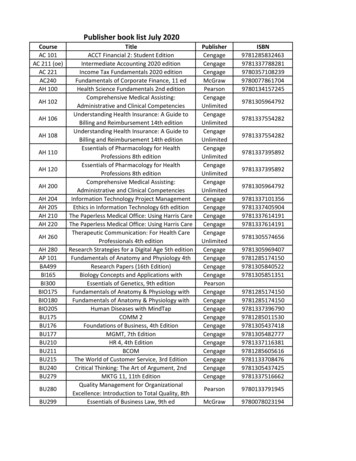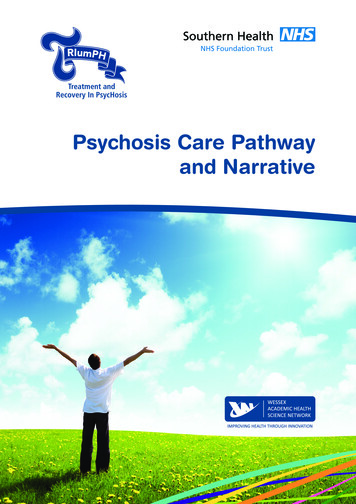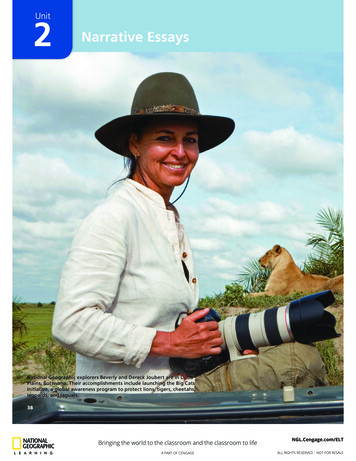
Transcription
Unit2Narrative EssaysNational Geographic explorers Beverly and Dereck Joubert are in DubaPlains, Botswana. Their accomplishments include launching the Big CatsInitiative, a global awareness program to protect lions, tigers, cheetahs,leopards, and jaguars.3894943 ch02 ptg01 hires 038-063.indd 388/27/13 7:03 PM
Objectives T o learn how to write a narrative essayTo use connectors and time relationship wordsTo understand adjective clausesCan you write a story abouta person who has donesomething inspirational?
What Is a Narrative Essay?A narrative essay tells a story. In fact, narrative is another word for story. In this unit, you willlearn how to organize and write a narrative essay. Even though the narrative essay has the same basicform as most other academic essays, it allows the writer to be a little more creative than academicessays usually do. Narratives can tell long stories or just a few minutes’ worth of excitement. While thenarrative essay has a particular structure, narrative ideas are often used in different writing tasks, suchas argument or compare-contrast.Structure of a StorySeveral important elements make up a good story:SettingThe setting is the location where the action in a story takes place.ThemeThe theme is the basic idea of the story. Very often the theme will deal with a topicthat is common in life or human nature, such as independence, envy, courage,failure, and success.MoodThe mood is the feeling or atmosphere that the writer creates for the story. Itcould be happy, hopeful, suspenseful, or scary. Both the setting and descriptivevocabulary create the mood in a narrative.CharactersThe characters are the people in the story. They are affected by the mood of thestory, and they react to the events in which they are involved.PlotThe plot is what happens in the story, that is, the sequence of events. The plotoften includes a climax or turning point at which the characters or events change.Just like other types of essays, an effective narrative essay also includes these elements: a thesis that sets up the action in the introduction transition sentences that connect events and help the reader follow the story a conclusion that ends the story action and provides a moral, prediction, or revelation40Unit 2 Narrative Essays
The IntroductionThe introduction of a narrative essay is the paragraph that begins your story. In theintroduction, you describe the setting, introduce the characters, and prepare your audience for theaction to come. Of course, the introduction should have a hook and a thesis.The Narrative HookYou learned in Unit 1 that the hook in an essay is the part of the introduction—usually the firstfew sentences—that grabs readers’ attention. Hooks are especially important in narrative essays becausethey help set the stage for the story. The hook makes readers start guessing about what will happen next.Let’s look at the hook from Essay 8 that you will read in Activity 2.I had never been more anxious in my life. I had just spent the last three endless hours tryingto get to the airport so that I could travel home.Does this hook make you want to know what happened to the narrator? The hook should makethe reader ask wh- questions about the essay. You may have thought of questions like these when youread the preceding hook: Who is the narrator and why is he or she anxious? Where is the airport? What made the trip to the airport seem endless? Why is this person going home?Activity 1 Identifying HooksRead the sentences below. Which three sentences would not be good hooks for a narrative essay?Put a next to these sentences. Be ready to explain why you think these sentences do not work well ashooks for narrative essays.1.The roar of race-car engines ripped through the blazing heat of the day.2.It was freezing on that sad December day.3.After my brother’s accident, I sat alone in the hospital waiting room.4. My friend and I should not have been walking home alone so late on that dark winternight.5.Whales are by far the largest marine mammals.6.She gave her friend a birthday gift.7. The gleaming snow lay over the treacherous mountain like a soft white blanket, makingthe terrain seem safe instead of deadly.8.The Russian dictionary that we use in our language class has 500 pages.9.Amber never expected to hear the deadly sound of a rattlesnake in her kitchen garden.10.A shot rang out in the silence of the night.41
The ThesisIn most types of essays, the thesis states the main idea of the essay and tells what theorganization of the information will be. However, in a narrative essay, the thesis introduces the actionthat begins in the first paragraph of the essay. Look at these example thesis statements:Now, as I watched the bus driver set my luggage on the airport sidewalk, I realized that myfrustration had only just begun.I wanted my mother to watch me race down the steep hill, so I called out her name and thennudged my bike forward.Because his pride would not allow him to apologize, Ken now had to fight the bully, and hewas pretty sure that he would not win.These thesis statements do not tell the reader what happens. They only introduce the action thatwill follow. The paragraphs in the body will develop the story.The BodyThe body of your narrative essay contains most of the plot—the supporting information. Theaction in the plot can be organized in many different ways. One way is chronological or time order.In this method, each paragraph gives more information about the story as it proceeds in time—the firstparagraph usually describes the first event, the second paragraph describes the second event, and so on.Transitional SentencesIn an essay with chronological organization, each paragraph ends with a transitional sentence.Transitional sentences have two purposes: (1) to signal the end of the action in one paragraph, and(2) to provide a link to the action of the next paragraph. These sentences are vital because they give yourstory unity and allow the reader to follow the action easily. The following example is from Essay 8 onpage 43, Paragraphs 2 and 3. Notice how the ideas in the last sentence of Paragraph 2 (the transitionalsentence, underlined) and the first sentence of Paragraph 3 (underlined) are connected.2This was my first visit to the international terminal of the airport, and nothing was familiar. I couldnot make sense of any of the signs. Where was the check-in counter? Where should I take myluggage? I had no idea where the immigration line was. I began to panic. What time was it? Wherewas my plane? I had to find help because I could not be late!3I tried to ask a passing businessman for help, but my words all came out wrong. He just scowledand walked away. What had happened? I had been in this country for a whole semester, and I couldnot even remember how to ask for directions. This was awful! Another bus arrived at the terminal,and the passengers stepped off carrying all sorts of luggage. Here was my chance! I could followthem to the right place, and I would not have to say a word.The ConclusionLike academic essays, narrative essays need to have concluding ideas. In the conclusion, youfinish describing the action in the essay. The final sentence can have two functions:1. It can deliver the moral of the story by telling the reader what the character(s) learnedfrom the experience.2. It can make a prediction or a revelation (disclosure of something that was not known before)about future actions that will happen as a result of the events in the story.42Unit 2 Narrative Essays
Look at these examples:MoralThe little boy had finally learned that telling the truth was the most importantthing to do.PredictionI can only hope that one day I will be able to do the same for another traveler whois suffering through a terrible journey.RevelationEvery New Year’s Eve, my wife and I return to that magical spot and remember theselfless act that saved our lives.Writer’s NoteStorytelling TipIf you describe the sights, smells, and sounds of the story, you will bring the story alive for thereader. Try to include a few adjectives in your sentences. The more descriptive the information,the more the reader will connect with the story you are telling. Make readers feel that they arethere with you as you experience what you are describing.In the following example, the writer uses adjectives (underlined) to add depth to the story bygiving additional information.I walked into the noisy classroom and looked for a place to sit down. In the back of the well-lit room, I saw an old wooden desk and walked toward it. After a few moments, theanxious students quieted down when they observed the prim English teacher enter the room.Activity 2 Studying a Narrative EssayDiscuss the Preview Questions with a classmate. Then read the essay and answer the questions thatfollow.Preview Questions1. Have you ever had trouble getting from one place to another while traveling? Where were you going?What happened that made this travel difficult?2. Can everyday people be considered heroes? What do you consider to be a heroic act?Essay 8Frustration at the Airport1I had never been more anxious in my life. I had just spent thelast three endless hours trying to get to the airport so that I could travelhome. Now, as I watched the bus driver set my luggage on the airportsidewalk, I realized that my frustration had only just begun.2This was my first visit to the international terminal of the airport,and nothing was familiar. I could not make sense of any of the signs.Where was the check-in counter? Where should I take my luggage? I hadno idea where the immigration line was. I began to panic. What time wasit? Where was my plane? I had to find help because I could not be late!43
345644I tried to ask a passing businessman for help, but my wordsall came out wrong. He just scowled and walked away. What hadhappened? I had been in this country for a whole semester, and I couldnot even remember how to ask for directions. This was awful! Anotherbus arrived at the terminal, and the passengers came out carrying allsorts of luggage. Here was my chance! I could follow them to the rightplace, and I would not have to say a word.I dragged my enormous suitcase behind me and followed thegroup. We finally reached the elevators. Oh, no! They all fit in it, butthere was not enough room for me. I watched in despair as the elevatordoors closed. I had no idea what to do next. I got on the elevator whenit returned and gazed at all the buttons. Which one could it be? Ipressed button 3. The elevator slowly climbed up to the third floor andjerked to a stop. A high, squeaking noise announced the opening of thedoors, and I looked around timidly.Tears formed in my eyes as I saw the deserted lobby and realizedthat I would miss my plane. Just then an elderly airport employee shuffledaround the corner. He saw that I was lost and asked if he could help. Hegave me his handkerchief to dry my eyes as I related my predicament. Hesmiled kindly, and led me down a long hallway. We walked up some stairs,turned a corner, and, at last, there was customs! He led me past all thelines of people and pushed my luggage to the inspection counter.When I turned to thank him for all his help, he was gone. Iwill never know that kind man’s name, but I will always remember hisunexpected courtesy. He helped me when I needed it the most. I canonly hope that one day I will be able to do the same for another travelerwho is suffering through a terrible journey.Unit 2 Narrative Essaysto scowl: to frowna terminal: an arrivaland departure pointfor some forms ofmass transportationto despair: thecondition of havingno hopeto gaze: to look atslowly and steadilyto jerk: to move withan abrupt motiontimidly: hesitantly,shylydeserted: emptyelderly: older; matureto shuffle: to walkby sliding one’s feetalong the grounda predicament: atroubling situationa courtesy: a kind orpolite action
Post-Reading1. What is the narrative hook? 2. Do you think the hook is effective? In other words, did it grab your attention? Why, or why not? 3. Where is the setting of this story? 4. What is the theme, or the basic idea, of “Frustration at the Airport”? 5. Read the final sentences in paragraphs 2, 3, 4, and 5. How does each one prepare the reader for theaction to come? 6. What do you think the mood of the story is? What feeling or atmosphere does the writer create? 7. List the characters in this essay. 8. What verb tense is used in “Frustration at the Airport”?the writer uses. . Write five verbs that 9. This essay is arranged in chronological order. In a few words, describe what happens first, second,third, and so on. 45
10. Underline the transitional sentences.11. Does the story end with a moral, prediction, or revelation?sentence here.Write the final Building Better Sentences: For further practice, go to Practice 8 on page 196 in Appendix 1.Activity 3Outlining PracticeBelow is an outline for “Frustration at the Airport.” Some of the information is missing. Reread theessay beginning on page 43 and complete the outline.Title: I. Introduction (Paragraph 1)A. Hook: I had never been more anxious in my life. I had just spent the last three endless hourstrying to get to the airport so that I could travel home.B. Thesis statement: II. BodyA. Paragraph 2 (Event 1) topic sentence: This was my first visit to the international terminal of theairport, and nothing was familiar.support1. The signs were confusing.2. I began to panic.3. Transition sentence: B. Paragraph 3 (Event 2) topic sentence: 1. He scowled and walked away.support2. I could not remember how to ask for directions.3. 4. Transition sentence: 46Unit 2 Narrative Essays
C. Paragraph 4 (Event 3) topic sentence: I dragged my enormous suitcase behind me and followedthe group.1. support2. I got on the elevator and looked at the buttons.3. 4. Transition sentence: D. Paragraph 5 (Event 4) topic sentence: Tears formed in my eyes as I saw the deserted lobby andrealized that I would miss my airplane.1. An airport employee offered to help.support2. 3. 4. Transition sentence: He led me past all the lines of people and pushed my luggage to theinspection counter.III. Conclusion (Paragraph 6)A. Close of the action: B. I will never know his name, but I will always remember his unexpected courtesy.C. D. Final sentence (moral, prediction, or revelation): 47
Activity 4Adding Supporting InformationThe following narrative essay is missing large parts of the story (supporting information in the body).As you read, add information that moves the story along. Be sure to write transition sentences at theend of paragraphs 2, 3, and 4. If you need more space, use a separate piece of paper.Essay 9A Bad Day12I should never have deleted the chain letter e-mail from mycomputer. The letter clearly warned me that if I did, I would have oneday of bad luck. Unlike my mother, I tend not to believe these types ofthings bringing bad luck: breaking a mirror, someone giving me the “evileye,” or even opening an umbrella in the house. As a result, I got rid ofthis superstitious e-mail with one quick click of the mouse. That night,however, as I fell asleep, I had the uncomfortable feeling that somethingwas not quite right.When I woke up the next morning, I was surprised to find that Ihad overslept and would be late for work. As I rushed down the stairs toeat a quick breakfast, I tripped over my bag and 3On my way to work, I decided to take a shortcut through an oldpart of town. 48Unit 2 Narrative Essayssuperstitious:irrational, believingin things that are notbased on scienceto trip: to stumble orfall
4When I arrived at work, I found a note from my boss on my desk.She wanted to see me right away. I took a deep breath and walked intoher office. As I stepped inside, I noticed a scowl on her face.right away:immediately 5Finally, after a long and difficult day, I returned home to find thatmy air conditioner was broken. I could not take it anymore! It had beenthe worst day ever, and I did not want anything else to happen. I rushedto my computer, opened up my e-mail, and went directly to the deletede-mail folder. I opened up the letter and reread the words: “Send tencopies of this e-mail to your friends, and you will have good luck for ayear.” I put on my reading glasses and began scrolling through my listof e-mail contacts. They could take their chances, but I was not going tohave any more bad luck!Building Better Sentences: For further practice, go to Practice 9 on page 196 in Appendix 1.49
GGrammar for WritingConnectors and Time Relationship WordsThe most common way to organize events in a narrative essay is in chronological order. Theevent that occurs first is in the introduction, and the events that follow are in the next paragraphs (thebody) and continue to the end (the conclusion).To make sure that readers understand time relationships, effective writers use connectingwords and phrases to show how events progress. Look at the time words in the chart below. These areconnectors that you can use in narrative writing.Chronological OrderPrepositionsTime Words That Begin Clauses *first (second, third, etc.)after (a moment)afternextat (9:00 a.m.)as soon asfinallyby (bedtime, then)beforelaterduring (the afternoon)untilnowfrom (then on)whenthenuntil (five o’clock)wheneverwhile*When time clauses occur at the beginning of a sentence, they MUST be followed by a comma.Sentence Variety with Prepositions of Time Plus Key Nounsfor Better CohesionEssays that are written using only one or two sentence patterns can be dull to read. Good writerstry to include variety in their sentences. Here are two ways to add variety with time words.1. Follow the time word after with a noun.Change Marta studied engineering at the University of Charleston. She graduated in 2013. Then shegot a job with Johnson and Rowe, a local engineering firm.to Marta studied engineering at the University of Charleston. After her graduation in 2013,she got a job with Johnson and Rowe, a local engineering firm.Change I walked up the stairs to the stage. I was so frightened to begin my speech that I couldactually hear my teeth chattering. I remembered my deep breathing exercise, lookedconfidently at my audience, and began to speak.to I walked up the stairs to the stage. I was so frightened to begin my speech that I couldactually hear my teeth chattering. After my deep breathing exercise, I looked confidentlyat my audience and began to speak.2. Follow after, before, while, and when with a gerund (an -ing verb form used as a noun)Change A rare golden Sitka spruce was cut down by vandals. It had been growing for more than threehundred years.to After growing for more than three hundred years, a rare golden Sitka spruce was cut downby vandals.Change Joanna Cannon ran for mayor. She promised to lower property taxes.to While running for mayor, Joanna Cannon promised to lower property taxes.*A gerund is a verb form that ends in -ing and is used as a noun, such as walking and studying.For a more complete list of connectors, see the Brief Writer’s Handbook with Activities, pages 180–181.50Unit 2 Narrative Essays
Activity 5Adding ConnectorsRead the essay. Fill in the blanks with an appropriate connector or time relationship word or phrase.Refer to the chart on page 50.Essay 10Becoming a Man1When they are asked who their idol is, most people will namea famous person. I am not most people. My idol is a person whom Ihave known my entire life. He is my brother Claudio, and even today heteaches me about life. The day that Claudio taught me the importanceof being a man is the day he left home to go to college.2It was an early Saturday morning in August. As usual, wewere woken up by the sound of our sister playing the piano. Shea fewwas always playing that silly instrument!minutes of lying in our beds, wishing she would stop, we slowly got up.that point, we knew we could not fall back asleep.She was probably going to play that piano all day!3we reached the kitchen, there was a surpriseMom saw us,for Claudio—his favorite breakfast.she gave us a big smile and told us to sit down for our pancakes. It wasobvious that this was an important day for everyonewe finishing breakfast, Claudio went upstairs to continue packing.an idol: herosilly: stupid, ridiculousto pack: to put clothesin a suitcase51
45I heard him call my name. I ran to the roomwe shared, sat down on the bed, and watched Claudio close his suitcase.He turned to me and nodded. “It’s time, brother,” he said. I thoughthe was referring to his time to leave the house. Actually, he went on toexplain all of the important responsibilities that I would have after hewas gone. Claudio meant that it was time for me to take on a bigger rolethat point, I understood everything.in the family.then on, I took my role as the “man of thehouse” very seriously. With Claudio away, I would need to be availablefor Mom whenever she needed me. What have I learned from mybrother? I have learned about family, love, and responsibility.to take on: undertake,facea role: job, functionBuilding Better Sentences: For further practice, go to Practice 10 on page 197 in Appendix 1.Grammar for WritingAdjective ClausesAdjective clauses are one of the most powerful ways to combine two ideas (simple sentences)into one complex sentence. Study the following rules and examples:1. Adjective clauses must contain a subject and a verb.2. The subject of an adjective clause can be who (people), which (things), or that (people or things).Samir studies at a university. The university is well known for its technology programs.adjective clauseSamir studies at a university that is well known for its technology programs.3. If the information in the adjective clause is necessary to clarify the person or thing you are writingabout, do not use a comma to separate the ideas. However, if the information in the adjective clauseis not necessary to understand the meaning of the sentence, use a comma, or pair of commas, toseparate the adjective clause from the rest of the sentence. In other words, commas indicate theinformation is extra. Study the examples below.52Necessary InformationUnnecessary InformationThe city that we will visit last on our trip is located in central Florida.Orlando, which we will visit last on our trip, islocated in central Florida.NOTE: When the writer says the city, it is notclear which city the writer is talking about. Theadjective clause (that we will visit last on our trip)is important information for readers because ittells them which city in central Florida the writer isreferring to.NOTE: When the writer says Orlando, the readersknow which city the writer is talking about. Theinformation about when the writer will visit thiscity does not affect our ability to know that thewriter is referring to Orlando.Unit 2 Narrative Essays
Activity 6Adjective Clause ReviewRead the following narrative essay. Find and underline the nine adjective clauses in the essay. Hint:Adjective clauses tend to begin with who, that, or which.Essay 11Learning to Drive1I could not believe it. Driving laws in Ontario allowed teenagersto get their licenses at the age of sixteen! As my sixteenth birthdayapproached, I beamed with excitement and anticipation. What I did notknow at the time was this: The driving lessons that I learned in our oldsedan would stay with me for the rest of my life.2My father, who adored driving, was the obvious choice to be mydriving instructor. The first lesson took place in the driveway. WhileI sat in the passenger seat, he explained the devices in the car. I wasparticularly frightened by the gear shift, which was sticking out of thefloorboard. However, my father patiently lectured on the different floorpedals, the turn signals, and, my favorite, the car horn.3For the next lesson, I sat in the driver’s seat. At that time, it feltmore like a throne than anything else. My father asked me to turnon the car, and then he guided me into reverse. As I let up on theclutch and pressed the gas, I felt the car starting to move backward.I was controlling this vehicle! Slowly and carefully, I backed out ofthe driveway and into the residential street. After a few moments ofconfusion, I had the car sputtering forward in first gear.a driveway: an areain front of a homewhere people parktheir carsa throne: a specialchair meant fornobilityresidential: areaswhere people live,not commercial53
4Two weeks of lessons passed, and I was beginning to get boredwith the scenery, which never changed. My father had me drive aroundthe same block again and again. I was passing the same landmarks—theneighbors’ houses, the dead tree down the street, and the kids who wereplaying in the empty lot on the corner. When I could stand it no more, Iasked to move to a street that had more action. “Tomorrow. I think youare ready,” my father replied, his eyes twinkling with pride.5My emotions were in overdrive the next day. I was finally ona busy street at night. I shifted from first gear to second gear withno problems. Then came third gear. When I reached the speed thatI wanted, I put the car into fourth. I was flying in the old sedan! Myfather’s concerned voice broke my spell. He said calmly, “Honey, there’sa red light ahead.” I was traveling far above the speed limit and headingtoward a red light. All the information that I had learned in the previousweeks leaked out of my brain. I did not know how to react. I blared thehorn and flew through the intersection, which by pure luck was empty.6That night my father was somber. I was in tears. How lucky we hadbeen not to have been hit by another car. I waited for him to reprimandme, but he did not. I was aware of the severity of my moving violation.It is now thirty years later, and I have not forgotten that day. In fact, if Iaccidentally drive through a red light now, I remember the emotions of asixteen-year-old and the wisdom of a loving father who taught her to drive.a sedan: a type of cara spell: a state ofbeing captivated bysomethingto leak out: escapefrom one’s memorysomber: seriousto reprimand: scold;lectureseverity: seriousnessa moving violation: atraffic offenseBuilding Better Sentences: For further practice, go to Practice 11 on page 198 in Appendix 1.Building Better VocabularyActivity 7Word AssociationsCircle the word or phrase that is most closely related to the word or phrase on the left. If necessary, use adictionary to check the meaning of words you do not know.54AB1. a scowla happy facean angry face2. a predicamentgood lucktrouble3. to shuffleearsfeet4. to gazeeyesmouth5. knowledgea lot of informationalmost no information6. idolcelebrityviolation7. somberseriousunderstandingUnit 2 Narrative Essays
8. residential*houses and apartmentsoffices9. drivewaycarspeoplefunnyserious10. severity*Indicates words that are part of the Academic Word List. See pages 183–184 for a complete list.Activity 8Using CollocationsFill in each blank with the word or phrase on the left that most naturally completes the phrase on theright. If necessary, use a dictionary to check the meaning of words you do not know.1. ask / to askhow2. journey / lobbya deserted3. feeling / letteran uncomfortable4. through / downto rush5. from / byhit6. by / onto trip7. do / maketo8. bed / tablesit down on the9. say / tellto10. lesson / streetfor helpthe stairsa carsomethingsense of somethingthe truthlearn aDeveloping a Narrative EssayWhen writing a narrative essay there are a few strategies that can help you. These are choosing atopic, brainstorming, and making an outline.Choosing a TopicWhen you write a narrative essay, choose a topic that is important to you—your essay will beeasier to write and more interesting to read if you do. Also remember that smaller is better. The smallerthe action or event you choose, the easier it will be to keep your readers’ interest and describe the actionfully. Choose a topic that you can write about in approximately five or six paragraphs. For example, itwould be impossible to describe—in one essay—all the events that helped make you the person you aretoday. However, you could choose one event that made a difference in your life, such as your first jobor a special award, and write an essay about that. At the same time, be careful that the topic you chooseis not too small. For example, a story about how your little brother called you a name one day wouldnot be a good topic for a narrative essay. There needs to be enough action to make a story of five or sixparagraphs.55
Writer’s NoteTopic TipWhen you think about possible topics for a narrative essay, try to remember somethingexciting, difficult, wonderful, or frightening that happened to you. Can this event be developedinto an interesting narrative essay?Ask Yourself QuestionsTo help you think of some possible topics for narrative essays, ask yourself questions. Use thefollowing questions as a guide: When was an important time in my life? Remember, the experience can be a very short one,such as “July 13, 2013,” in which the writer describes a five-minute segment of her life. What has happened in my experience that I would enjoy writing about? Is there an event in my life that other people (readers) would enjoy hearing about? How did I feel about a particular experience? Who was involved? Why do I remember this event so strongly? What effect did it have on me? Did anything change because of this experience? What interesting experiences do I know of that happened to other people?If you are able to answer some of these questions about a specific experience that you orsomeone else had, then you may have a topic for a narrative essay.Activity 9 Choosing TopicsLook at the pairs of topics. Put a next to the topic that is the better choice for a narrative essay.56Unit 2 Narrative Essays
1.Your last year in high schoolYour last day in high school2.A scary airplane ride
42 Unit 2 Narrative Essays The Thesis In most types of essays, the thesis states the main idea of the essay and tells what the organization of the information will be. However, in a narrative essay, the thesis introduces the action that begins in the first paragra
